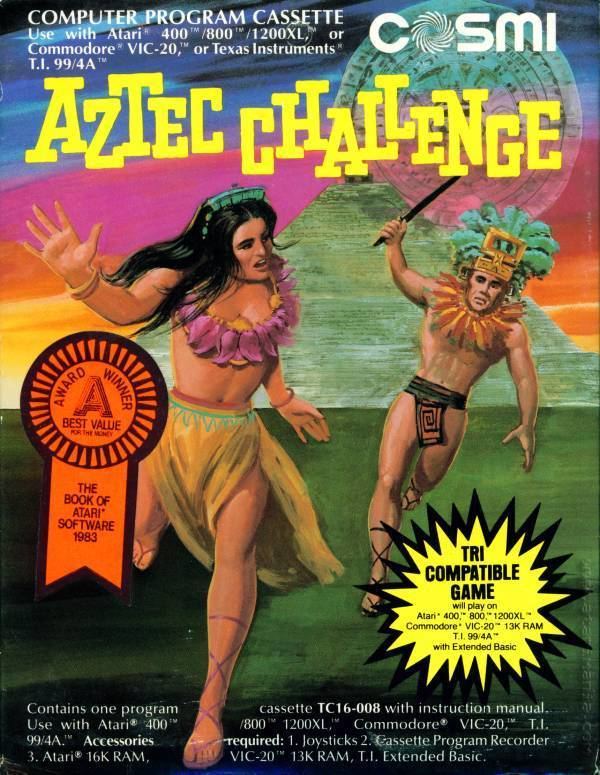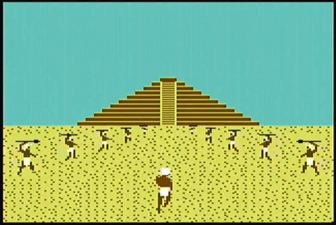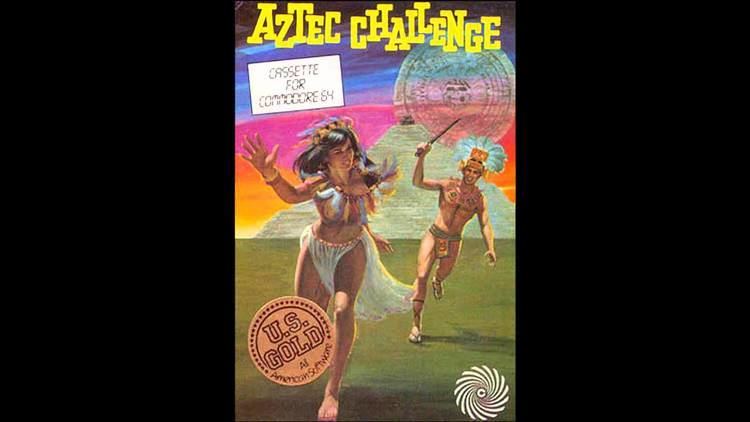10 /10 1 Votes10
Initial release date 1982 | 5/5 My Abandonware | |||||||||||||||||||||||||||||||||
 | ||||||||||||||||||||||||||||||||||
Similar Cosmi Corporation games, Other games | ||||||||||||||||||||||||||||||||||
Aztec Challenge refers to either of two early arcade-style computer games published by COSMI, as well as to subsequent remakes. In all game versions the player takes control of a running Aztec warrior. The first was a side-scrolling platform-jumping game created by Robert Tegel Bonifacio and released in 1982 for the Atari 8-bit family. Subsequently a different game with the same title and overall theme was created by Paul Norman and released for the Commodore 64. It included a level in a modified-first-person 3D-style.
Contents
- C64 gameplay with commentary aztec challenge
- Atari 8 bit computer version 1982
- Different versions
- Gameplay
- Music
- Reception
- Remakes and clones
- References

C64 gameplay with commentary aztec challenge
Atari 8-bit computer version (1982)

The original version of the game on the Atari 8-bit computers presented itself as a side-scroller, with the player's character running continuously from left to right as the background and path continuously scrolled. Control was limited to jumping at three different heights; holding the joystick down and pressing the button resulted in a low jump, holding the joystick up and pressing the button resulted in a high jump, and pressing the button by itself resulted in a medium jump. The running speed of the character was constant; only the height of the jumps differed, although speed of the character gradually increased of its own accord with each passing level. In two-player mode, each player controlled a different colored character with one character running in front of the other. The object of the game was to cover as much distance as possible without succumbing to the assorted perils of the path. Obstacles included platforms and ceilings of differing heights, pits, spikes, platform steps of staggered heights, and other assorted pitfalls. Contact with any part of the landscape other than the path would result in the loss of a player's life and would return the player to the last checkpoint.

The game's collision detection system had a reputation of being utterly unforgiving, often killing a character for the sake of a single pixel. Coupled with the inability to save a game in progress or resume from a specific level, this was the cause of much frustration. Level changes were indicated by an overall color shift in the game, a very brief hiatus where the character was running on an level surface, and a slight increase in the character's running speed. Completing each level became a matter of determining what height jump to use and exactly when to use it, usually (especially in the higher levels) though a system of trial and error.
Different versions

There was more than one different version of Aztec Challenge on the Atari 8-bit, although (unlike the very different Commodore 64 release) all featured the same basic side-scrolling gameplay.
The game was originally released as The Bonifas through the Atari Program Exchange under a non-exclusive agreement. However, the title was picked up almost immediately for distribution by Cosmi, who renamed it Aztec Challenge and had a simultaneous two-player option added.
In 1983, Cosmi released another version (still sold as Aztec Challenge) featuring significantly improved graphics, but similar gameplay.
Gameplay
The player must guide their character through seven different levels. In every level new deadly perils lurk for the hero. The first, entitled The Gauntlet, is probably the most famous level. It sees the player running towards a temple in the distance. On the left and right are some aztecs, who throw spears at the player, who must duck under the spear or jump over it (depending on the height the spear is coming at). If the player fails to avoid a spear they are placed back at the start of the level.
In the second level, The Stairs, the player is required to dodge left and right to avoid stone blocks thrown down at them as they ascend the stairs of the temple.
Level 3 is The Temple which features traps which must be avoided by pausing the protagonist's motion or jumping.
Level 4, The Vermin works in a similar way to the preceding level with the control system offering the choices of high and low jumps in this section.
Level 5, Hopaztec, asks the player to cross a tile-filled room, avoiding booby-trapped tiles.
In Level 6, Piranha, the player must swim across a lake avoiding the deadly man-eating fish.
Level 7, The Bridge is the final level. The player runs automatically to the right and gaps in the bridge must be traversed by low, medium or high jumps depending on the size of the gap.
Music
The most memorable feature of the game was its exciting and immersive music, which Paul Norman (the game author) composed himself. (He was a musician before becoming a computer programmer.)
The slowly, but gradually unfolding tunes became increasingly tense and complex as the player was progressing through the long, monotonic and increasingly difficult levels. The music served as a reward to the player for the sustained gameplay "effort".
Reception
Your Commodore's reviewer praised the "high standard of graphics and sound" in the game and thought it was "one of the best games around."
Remakes and clones
This game was remade in 2003 by Paul Norman as Azteca: Queen of Quezalcoatl, It is only found on his website, DigiTTARIUS.
A clone named A-VCS-tec Challenge including the modified-first-person 3-D style was developed from 2002 to 2006 by Simon Quernhorst for the Atari 2600
